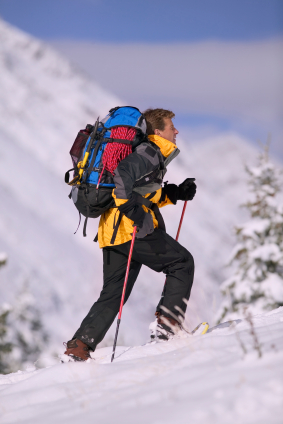 I’ve recently discovered that one of my most popular posts is Hiking in the Rain. So, just having returned from the Great Smoky Mountains where I hiked in subfreezing temperatures for a few days, I thought I’d pass along what I learned.
I’ve recently discovered that one of my most popular posts is Hiking in the Rain. So, just having returned from the Great Smoky Mountains where I hiked in subfreezing temperatures for a few days, I thought I’d pass along what I learned.
- Clothing. All of you just said “Duh!” Dress in lots of thin layers rather than fewer large ones. As you hike, your body will heat up and that really heavy parka that seemed like a great idea in the beginning will be coming off after about 30 minutes. At times in the Smokies in subfreezing weather, I wearing only my polypropylene underwear, a long sleeve tshirt and a light fleece. The key is to maintain your core temperature. If it drops much, your extremities respond by restricting the blood flow to conserve heat for the vital organs in your core. Your fingers and toes will start to go numb, followed by larger extremities unless your core temperature stabilizes. If it rises much, you’ll begin to sweat, leaving you wet and eventually cooler than before. Layers give you options, allowing you to customize your comfort.
- Hat. Always bring a covering for your head. A ball cap is better than nothing, but a brimmed hat will keep falling snow off of you. I wear a beanie type hat than can cover my ears. I treat it like my very first layer. If I sweat, the hat’s off and if I’m cold, the hat’s on.
- Gloves. If you keep your core temperature up, your fingers will still get cold so bring gloves with you. I take mine off and on as its comfortable.  If it’s really cold, you may want to try layering gloves and liners or use heavier ski gloves. Hand warmers do work nicely and some gloves are made with pockets for them. Mittens are also an option, as they allow your fingers to warm each other. Fingers are colder in gloves because they are isolated. Mittens will obviously restrict what you can do with your fingers, so keep that in mind.
- Footwear. When considering the location you’ll be hiking in, remember you may encounter snow, slush, and (even worse) ice. A trail that has a spring running down a length of it during the summer will probably be frozen solid and you’ll have to cross that. In extreme cases, remember crampons and snowshoes. At a minimum, wear sturdy high top waterproof hiking boots and bring your trekking poles for stability.
- Food and water. Your food and water may freeze, so keep that in mind. Putting hot tea, coffee, or soup in a thermos makes for a nice lunchtime warm up. Consider keeping your water bottle and food close to your body to keep them from freezing. Nothing’s worse than trying to eat a frozen energy bar or drink frozen water.
- Rain gear. Bring it and use it. You can use the jacket and pants as an extra insulating layer if needed. If you get wet with rain, melting snow, or sweat, you really add to the risk of hypothermia.
I’ve compiled these tips based on my own personal experience and it’s certainly not exhaustive. Think about your route and the conditions you will likely encounter and prepare for them.
It’s certainly easier to sit by the fireplace and drink hot cocoa on a cold day, but there’s a wonderful world outside that most people never get to see. What tips do you have for hiking in cold weather?